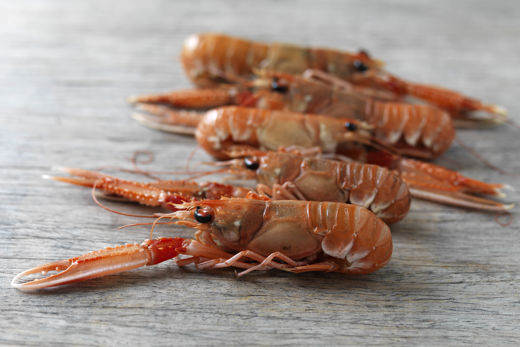Langoustine Delights: Recipes, Cooking Tips, and More
Welcome to a culinary journey dedicated to the exquisite world of langoustines. These delectable shellfish, often referred to as “mini-lobsters,” are prized for their succulent meat and delicate flavor. In this article, we’ll dive deep into the realm of langoustines, exploring their taste, culinary versatility, and the art of preparing them. Whether you’re a seasoned chef or an aspiring home cook, join us as we unravel the secrets of making langoustines the star of your dining experience.
Cooking with Langoustines: Recipes and Techniques
Now that we’re acquainted with these marine marvels, it’s time to explore the exciting world of cooking with langoustines. Their versatility in the kitchen knows no bounds. From delicate starters to luxurious main courses, langoustines can elevate any meal to a gourmet experience.

Sourcing and Sustainability
Langoustines are a prized ingredient, but where and how you source them can make a significant difference in both taste and environmental impact. In this section, we’ll explore the best practices for obtaining langoustines while considering sustainability.
Where to Find Langoustines
Seafood Markets:
Many reputable seafood markets and fishmongers carry fresh or frozen langoustines. These establishments often have knowledgeable staff who can provide guidance on selecting the best specimens.
Online Seafood Retailers:
The digital age has made it easier than ever to access specialty seafood. Numerous online retailers now offer langoustines that can be shipped directly to your doorstep, ensuring freshness.
Sustainability Matters
As responsible consumers, it’s crucial to consider the sustainability of our seafood choices. Langoustines are no exception. Being informed about the sustainability of langoustine sources helps protect both the environment and future generations’ ability to enjoy this culinary delight.
Tips for Sustainable Langoustine Selection:
Check for Certifications:
Look for certifications such as the Marine Stewardship Council (MSC) or Aquaculture Stewardship Council (ASC). These indicate that the langoustines were sourced from sustainable fisheries or responsible aquaculture.
Seasonal Awareness:
Be mindful of the langoustine season in your region. Harvesting langoustines during their peak season helps ensure a healthy population and minimizes the impact on marine ecosystems.
Ask Questions:
When buying langoustines, don’t hesitate to ask your supplier about the source and fishing methods. Responsible sellers should be able to provide information on their products’ origins.
Langoustine-Related Terms and Glossary
Langoustine cuisine often comes with its own set of culinary terms and jargon. Understanding these terms can enhance your appreciation of langoustine dishes and help you navigate menus with confidence. Here’s a glossary of some key langoustine-related terms:
Scampi:
While the term “scampi” is often used to refer to a preparation method involving langoustines, it originally referred to a type of Mediterranean lobster. In many recipes, langoustines are prepared scampi-style with garlic, butter, and white wine.
Bisque:
A bisque is a smooth and creamy soup often made with langoustines. It’s known for its rich flavor and luxurious texture, making it a favorite among langoustine enthusiasts.
Broil:
Broiling is a cooking method that involves exposing food to direct heat from above. Langoustines can be broiled with butter and seasoning for a quick and flavorful preparation.
Poaching:
Poaching langoustines involves gently simmering them in liquid, often a court bouillon, until they’re tender and flavorful. Poached langoustines are commonly served cold.
Ceviche:
Although not as traditional, langoustines can be used in ceviche, a Latin American dish where seafood is “cooked” in citrus juices, typically lime or lemon. The acid in the juice firms up the langoustine’s flesh and imparts a tangy flavor.
Bouillabaisse:
This is a traditional Provençal fish stew that can feature langoustines alongside various other seafood. It’s known for its aromatic broth, usually flavored with herbs and spices.
Batter:
Langoustines are sometimes coated in a light, crispy batter before frying. This method is commonly used in dishes like tempura or langoustine fritters.
Tails and Heads:
In langoustine dishes, you’ll often come across references to “tails” and “heads.” The tail meat is the sweet and tender part of the langoustine, while the heads can be used to make flavorful stocks and sauces.
Cooking Techniques: Grilling, Boiling, and More
Now that we’ve explored the basics of langoustine cuisine and mastered some key terms, it’s time to dive into the art of cooking langoustines. These exquisite shellfish lend themselves to a variety of cooking techniques, each offering a unique flavor and texture profile. Let’s explore some popular methods:
Grilling:
Grilling langoustines is a fantastic way to infuse them with smoky, charred flavors. To grill langoustines, simply split them lengthwise, brush with olive oil, season with salt and pepper, and grill over medium-high heat for a few minutes on each side. The grill marks add a delightful visual appeal to your dish.
Boiling:
Boiling langoustines is a classic method that maintains their natural sweetness. Fill a large pot with salted water and bring it to a boil. Add the langoustines and cook for 3-4 minutes until they turn bright pink and the flesh becomes opaque. Drain and serve with melted butter or a zesty dipping sauce.
Broiling:
Broiling langoustines in the oven is quick and convenient. Place split langoustines on a baking sheet, brush with butter and seasoning, and broil for a few minutes until they’re lightly browned and sizzling. Be attentive to prevent overcooking.
Steaming:
Steaming langoustines is a gentle method that preserves their delicate flavor and texture. Place langoustines in a steamer basket over simmering water and steam for about 5-6 minutes until they’re cooked through. Serve with a drizzle of lemon-infused olive oil.
Frying:
For a crispy twist, you can batter and fry langoustines. Dip them in a light batter made with flour, sparkling water, and a pinch of salt, then deep-fry until golden brown. The result is a delightful contrast of a crunchy exterior and tender interior.
Poaching:
Poaching langoustines in a fragrant court bouillon or flavorful broth can create a succulent and aromatic dish. Simmer the langoustines gently in the liquid for a few minutes until they’re opaque, then serve with the reduced poaching liquid as a sauce.
Langoustine Health Benefits: Nutritional Value
Beyond their exquisite taste and culinary versatility, langoustines offer notable nutritional value that can contribute to a balanced diet. In this section, we’ll explore the nutritional profile of langoustines and discuss potential health benefits associated with their consumption.
Nutritional Highlights:
Langoustines are a seafood delicacy that provides a range of essential nutrients in each delectable bite:
Protein:
Langoustines are a excellent source of high-quality protein, crucial for muscle maintenance and overall body function.
Low in Calories:
They are relatively low in calories, making them an ideal addition to a calorie-conscious diet.
Low in Fat:
Langoustines are naturally low in fat, particularly saturated fat, which is known to be less heart-healthy.
Rich in Vitamins:
They are a good source of vitamins like B12 and B3 (niacin), essential for energy metabolism and maintaining healthy skin.
Mineral Content:
Langoustines contain important minerals such as zinc, phosphorus, and selenium, which are vital for various bodily functions, including immune support and bone health.
Health Benefits:
Consuming langoustines as part of a balanced diet can offer several potential health benefits:
Heart Health:
The low-fat and low-saturated fat content of langoustines can contribute to heart health by helping to manage cholesterol levels.
Weight Management:
Their low-calorie and high-protein nature can support weight management and muscle maintenance.
Vitamin Intake:
Langoustines provide essential vitamins, aiding in energy production and overall well-being.
Mineral Support:
The minerals found in langoustines play crucial roles in various bodily functions, promoting overall health.
Omega-3 Fatty Acids:
While langoustines are not as rich in omega-3 fatty acids as some other seafood, they still contribute to your intake of these heart-healthy fats.
The Art of Presentation: Plating Langoustine Dishes
Creating an exquisite langoustine dish isn’t just about taste; it’s also about presentation. Elevating the visual appeal of your langoustine creations adds an extra layer of culinary delight to your dining experience. In this section, we’ll explore the art of plating langoustine dishes like a pro.
Mindful Plating:
The first rule of plating langoustine dishes is to be mindful of the aesthetics. Consider the color, shape, and size of your ingredients and how they complement each other. Langoustines, with their vibrant orange-pink hue, make a striking centerpiece on any plate.
Garnishes and Herbs:
Garnishes and fresh herbs are your best friends when it comes to enhancing the visual appeal of langoustine dishes. A sprinkle of finely chopped parsley, a sprig of dill, or a drizzle of vibrant, herb-infused oil can elevate the overall presentation.
Sauce Drizzles:
Artful drizzles of sauce around the plate not only add flavor but also create an attractive contrast. Use a squeeze bottle or a small spoon to create delicate designs with sauces like hollandaise or a reduction of the langoustine cooking liquid.
Plate Shapes and Colors:
The choice of plates can significantly impact presentation. Consider the color and shape of your plates; white plates often provide an excellent backdrop for showcasing the vibrant colors of langoustines and accompanying ingredients.
Height and Balance:
Creating height and balance on the plate is another key element. Stack langoustines or arrange them in a way that adds dimension to your presentation. Use other ingredients like vegetables to create height variations.
Negative Space:
Don’t overcrowd the plate. Leave some negative space to allow your diners’ eyes to focus on the langoustines and their artistic surroundings. The arrangement should be inviting and visually appealing.
Utensils and Table Setting:
Consider the utensils and table setting as part of the overall presentation. Polished silverware, elegant glassware, and carefully folded napkins can complete the dining experience.
Frequently Asked Questions (FAQs) about Langoustines
What are langoustines, and how are they different from other seafood?
Langoustines, also known as Norway lobsters or Dublin Bay prawns, are a type of shellfish. They are similar in appearance to lobsters but smaller. Langoustines are prized for their delicate flavor and sweet, tender meat.
Where can I buy langoustines for cooking at home?
You can purchase langoustines from seafood markets, fishmongers, and even online seafood retailers. Many specialty grocery stores also carry frozen langoustines.
What is the best way to cook langoustines?
Langoustines can be prepared using various methods, including grilling, boiling, broiling, and poaching. The best way to cook them depends on your preference and the recipe you’re following.
Are langoustines sustainable seafood?
Sustainability can vary depending on the source. Look for certifications like the Marine Stewardship Council (MSC) to ensure you’re making a sustainable choice when buying langoustines.
Can langoustines be used in both appetizers and main dishes?
Yes, langoustines are incredibly versatile. They can be used in a wide range of dishes, from elegant appetizers like langoustine scampi to luxurious main courses like langoustine bisque.
Are there any nutritional benefits to eating langoustines?
Langoustines are a good source of high-quality protein, low in calories, and low in saturated fat. They also provide essential vitamins and minerals like B12, B3 (niacin), zinc, and selenium.
What are some popular langoustine recipes?
Popular langoustine recipes include langoustine scampi, langoustine bisque, langoustine ceviche, and langoustine tempura. The options are diverse and delicious.
Can langoustines be used in seafood stews or soups?
Yes, langoustines can enhance the flavor of seafood stews and soups, adding a touch of sweetness and depth to the broth.
What are the best wine pairings for langoustine dishes?
Crisp white wines like Sauvignon Blanc or Chardonnay pair well with langoustine dishes. Sparkling wines and Champagne also complement the delicate flavors.
Are there any precautions or allergen considerations when cooking with langoustines?
Langoustines are shellfish, so individuals with shellfish allergies should avoid them. When handling raw langoustines, practice proper food safety to prevent cross-contamination.
Conclusion:
In our culinary exploration of langoustines, we’ve uncovered the secrets of transforming these exquisite shellfish into memorable dining experiences. From understanding their taste and sourcing them sustainably to mastering various cooking techniques and appreciating their nutritional value, langoustines have proven to be culinary treasures.




